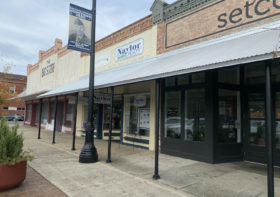Secretary Lee Announces the Designation of DeFuniak Springs’ First Hospital in the National Register of Historic Places

For Immediate Release
Tuesday, November 23, 2021
Contact: Mark Ard
850-245-6522
[email protected]
TALLAHASSEE, FLA. –
Florida Secretary of State Laurel M. Lee announced today that Lakeside Hospital in DeFuniak Springs, Walton County, has been listed in the National Park Service’s National Register of Historic Places.
“I am pleased to announce that the Lakeside Hospital has been listed in the National Register of Historic Places,” said Secretary of State Laurel M. Lee. “This property was the first hospital constructed in DeFuniak Springs and provided critical medical care for over thirty years to thousands of local residents.”

Lakeside Hospital: First Floor built in 1939, Second Floor completed in 1948.
Built in 1939, the Lakeside Clinic began as Walton County’s first medical facility. Established by Dr. Ralph Spires, the clinic was a successful medical practice which also provided house visits. The Lakeside Clinic served as a safe place for pregnant women and offered care for people from all economic and social classes.
In 1948, Dr. Spires completed a large addition to the building and changed its name to Lakeside Hospital. The addition doubled the size of the building, including a full second floor, an elevator, and a segregated ward behind the hospital. At the time, many medical facilities did not treat African Americans and Lakeside Hospital was the only facility that offered treatment to Black residents in Walton County. Dr. Spires wanted to have a place to treat all patients in need.
The completion of the hospital’s addition also allowed for the expansion of hospital staff, including a dentist and several surgeons. Throughout the hospital’s operation, Dr. Spires and his partner Dr. Edgar Myers delivered hundreds of babies, in addition to helping patients with varied medical conditions. They introduced the use of incubators for premature babies, which was an innovative practice at the time. Even after the hospital closed in 1972, doctors continued to use the hospital’s first floor for medical offices until 2014.
Lakeside Hospital is a two story, brick colonial revival building, which fronts Lake DeFuniak. The building is characterized by four, two story columns on the front, enclosing first and second floor porches. Lakeside Hospital is now owned by the Florida Chautauqua Association, https://floridachautauquaassembly.org/, which uses it as their headquarters. The building is currently undergoing rehabilitation following damage by Hurricane Michael in 2018.
###
About The National Register of Historic Places
The National Register of Historic Places is a list maintained by the National Park Service which includes historical or archaeological properties including buildings, structures, sites, objects, and districts, that are considered worthy of preservation because of their local, statewide and/or national significance. Nominations for properties in Florida are submitted to the National Park Service through the Florida Department of State’s Division of Historical Resources. Florida has over 1,700 listings on the National Register, including 295 historic districts and 175 archaeological sites. There are more than 50,000 sites contributing to the National Register in Florida. For more information, visit flheritage.com/preservation/national-register. For more information about the National Register of Historic Places program administered by the National Park Service, visit nps.gov/nr.
About The Florida Department of State’s Bureau of Historic Preservation
The Bureau of Historic Preservation (BHP) conducts historic preservation programs aimed at identifying, evaluating, preserving, and interpreting the historic and cultural resources of the state. The Bureau manages the Florida Main Street Program, and under federal and state laws, oversees the National Register of Historic Places program for Florida, maintains an inventory of the state’s historical resources in the Florida Master Site File, assists applicants in federal tax benefit and local government ad valorem tax relief programs for historic buildings, and reviews the impact that development projects may have on significant historic resources. For more information, visit flheritage.com/preservation.



